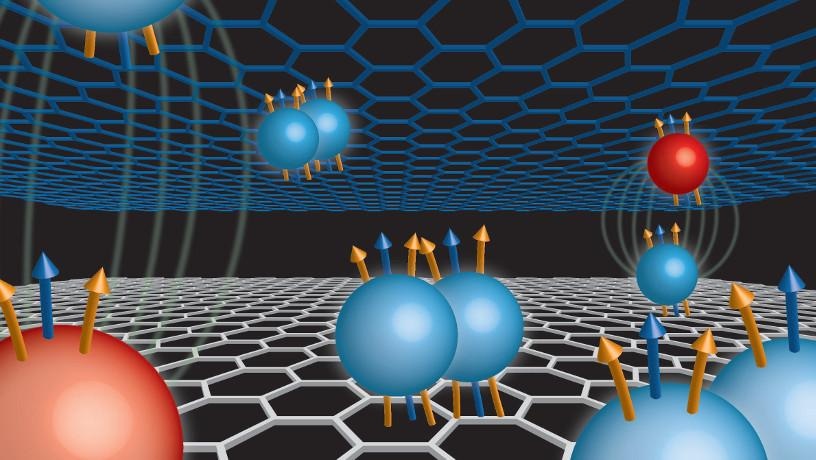Jun 26 2019
Scientists from Columbia and Brown Universities have revealed formerly unidentified states of matter that occur in double-layer stacks of graphene—a two-dimensional nanomaterial.
 A new type of quasiparticle is discovered in graphene double-layer structure. This so-called composite fermion consists of one electron and two different types of magnetic flux, illustrated as blue and gold colored arrows in the figure. Composite fermions are capable of forming pairs, such unique interaction leads to experimental discovery of unexpected new quantum Hall phenomena. (Image credit: Columbia University)
A new type of quasiparticle is discovered in graphene double-layer structure. This so-called composite fermion consists of one electron and two different types of magnetic flux, illustrated as blue and gold colored arrows in the figure. Composite fermions are capable of forming pairs, such unique interaction leads to experimental discovery of unexpected new quantum Hall phenomena. (Image credit: Columbia University)
Called the fractional quantum Hall effect, these new states, stem from the complex interactions of electrons within as well as across graphene layers.
The findings show that stacking 2D materials together in close proximity generates entirely new physics. In terms of materials engineering, this work shows that these layered systems could be viable in creating new types of electronic devices that take advantage of these new quantum Hall states.
Jia Li, Assistant Professor of Physics, Brown University
Li began this work while he was a post-doc at Columbia University working with Jim Hone, professor of mechanical engineering, and Cory Dean, professor of physics.
The study has been reported in the journal, Nature Physics.
According to Hone, Wang Fong-Jen Professor of Mechanical Engineering at Columbia Engineering, essentially, many of these new quantum Hall states “may be useful in making fault-tolerant quantum computers.”
The Hall effect appears upon applying a magnetic field to a conducting material in a direction perpendicular to the current flow. Due to the magnetic field, the current is deflected, generating a voltage in the transverse direction, known as the Hall voltage. When the strength of the magnetic field increases, the strength of the Hall voltage also increases.
The quantum version of the Hall effect was first identified in experiments carried out in 1980 at strong magnetic fields and low temperatures. The experiments exhibited that instead of increasing seamlessly with the strength of the magnetic field, the Hall voltage increases in step-wise (or quantized) manner. Such steps are integer multiples of basic constants of nature and are completely independent of the physical composition of the material employed in the experiments. The finding was awarded the 1985 Nobel Prize in Physics.
After a few years, scientists working at temperatures near absolute zero and with extremely strong magnetic fields discovered new kinds of quantum Hall states, wherein the quantum steps in Hall voltage correspond to fractional numbers, thus the term fractional quantum Hall effect. The finding of the fractional quantum Hall effect received another Nobel Prize in 1998. Theorists later proposed that the fractional quantum Hall effect is associated with the creation of quasi-particles known as composite fermions. Each electron, in this state, integrates with a quantum of magnetic flux to create a composite fermion carrying a fraction of an electron charge leading to the fractional values in Hall voltage.
The composite fermion theory has been effective in describing numerous phenomena found in single quantum well systems. This new study employed double-layer graphene to examine what exactly occurs when two quantum wells are brought close together. Theory had implied that the interaction between two layers would result in a new kind of composite fermion; however, this had never been noticed in the experiment.
For the experiments, the group built on several years of work at Columbia University to enhance the quality of graphene devices, producing ultra-clean devices completely from atomically flat 2D materials. The central part of the structure includes two layers of graphene separated by a thin layer of hexagonal boron nitride acting as an insulating barrier. The double-layer structure is covered by graphite as a conductive gate, and hexagonal boron nitride as a protective insulator to vary the density of the charge carrier in the channel.
Once again the incredible versatility of graphene has allowed us to push the boundaries of device structures beyond what was previously possible. The precision and tunability with which we can make these devices is now allowing us to explore an entire realm of physics that was just recently thought to be totally inaccessible.
Dean, Professor of Physics, Columbia University
The graphene structures were subsequently subjected to strong magnetic fields, which were millions of times stronger than the magnetic field of Earth. The study created a variety of fractional quantum Hall states, some of which show outstanding compliance with the composite fermion model, and some that had never been anticipated or observed.
Apart from the interlayer composite fermions, we observed other features that cannot be explained within the composite fermion model. A more careful study revealed that, to our surprise, these new states result from pairing between composite fermions. Pairing interaction between adjacent layers and within the same layer give rise to a variety of new quantum phenomena, making double-layer graphene an exciting platform to study.
Qianhui Shi, Study Co-First Author and Postdoctoral Researcher, Columbia University
“Of particular interest,” says Hone, “are several new states that have the potential of hosting non-Abelian wave functions—states that don’t quite fit the traditional composite fermion model.”
In non-Abelian states, electrons retain a type of “memory” of their previous positions in relation to each other. That has the possibility in allowing quantum computers that do not need error correction, which is presently a main stumbling hindrance in the field.
“These are the first new candidates for non-Abelian states in three decades,” Dean said. “It’s really exciting to see new physics emerge from our experiments.”